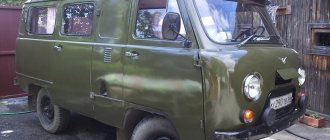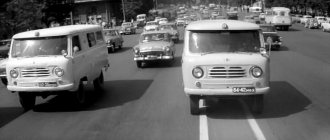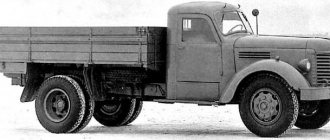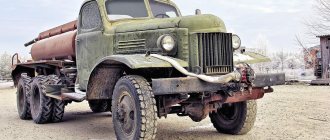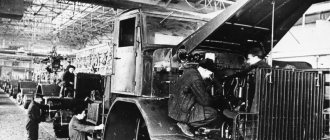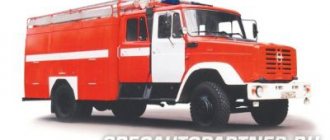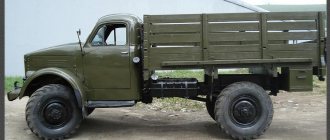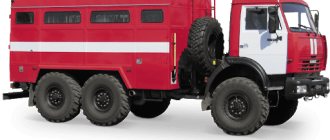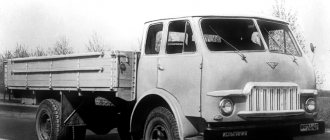A new classification for ZIL vehicles was adopted in 1986, and from that time the ZIL-431412 chassis began life, which began to be assembled at UAMZ.
The main difference from the old ZIL-130 was a modernized 150-horsepower gasoline engine, a new front suspension and a five-speed gearbox.
ZIL-431412 became the base chassis for many modifications of special vehicles of this brand.
They are most widely used in housing, communal and urban services, among power engineers, communications specialists and road service specialists.
History of creation
The modernized version of the ZIL-164 did not radically change the situation; a new, fundamentally new machine was needed. In 1953 At the ZiS plant they began developing a new vehicle under the designation ZiS-125; in the design documentation it was listed as ZiS-150M. In the process of work, several prototypes were created, one of them, assembled in 1956, received the designation ZIL-130. Initially, the car had an experimental carburetor V-shaped, six-cylinder engine with a displacement of 5.2 liters and a power of 135 hp. However, the next prototype, manufactured in 1957. They installed a souped-up engine from the ZIL-150, but it often overheated, and a decision was made to develop a new engine. Based on the power unit of the government limousine ZIL-111, a V-shaped, eight-cylinder, 150 hp engine designed for A-76 gasoline was created. At that time, the car turned out to be very advanced. It was equipped with power steering, a synchronized gearbox, an engine pre-heater, and a spacious three-seater cabin with panoramic glass, for those times, turned out to be very comfortable. It was equipped with a good heater, and there were two hatches in the roof for ventilation. In addition, the car had a smooth ride unusual for trucks. It is worth noting that the height of the ZIL-130 body was 1400 mm, which was equal to the height of the floor of the railway pasture. This made it possible to carry out loading and unloading without the use of ramps and forklifts. It took six years to fine-tune and test the ZIL-130. In September 1962 The first pilot batch of trucks was produced, and mass serial production began on October 1, 1964. The ZIL-130 became the first Zilov truck to receive a civilian color scheme of blue and white instead of army green.
The car turned out to be very reliable and durable, its estimated mileage before major repairs was 300,000 km. In 1973, the ZIL-130 car was awarded the Quality Mark. In July 1975 ZIL-130 began to be produced at the Chita Automobile Assembly Plant. The car was produced without changes until 1976. Then the ZIL-130-76 began to come off the assembly line; it differed from the original model in its increased payload capacity, up to six tons, and a slightly modernized engine and gearbox. The radiator lining and the location of the light fixtures have changed - the headlights and sidelights have swapped places. But in essence it was the same ZIL-130, the main drawback of which remained its voracious gasoline engine. In the early 1980s, a modification of the car was developed that ran on gas; the gasoline system remained as a backup. In 1986, cars of the ZIL-130 family changed their indices; in accordance with the new marking, the ZIL-130 began to be designated ZIL-431410. The ZIL-130 was sold well abroad; it was supplied to more than forty countries around the world. If necessary, the car could be equipped with an English Perkins diesel engine with a power of 140 hp. And at the Autoexport subsidiary in Finland, Konela, the ZIL-130 was equipped with a third non-driving axle, which increased the load capacity to 8 tons. The ZIL-130 became one of the most popular Soviet trucks. Its production at the Moscow plant continued until December 1994. The daily production was about 300 cars. During this time, 3,383,312 vehicles were produced. From 1995 to 2010 ZIL-130, under the symbol “43140”, was produced at the Ural Automotive Plant (UAMZ).
Truck crane on base vehicle chassis
The most widely used cranes in low-rise construction or dispersed work areas are the KS-2561K cranes.
The simplicity of the design, which is not burdened with complex mechanisms, reliability, quick preparation time for work and small dimensions make it an easy choice in favor of this unit.
The 8 m long lattice boom truss can be extended up to 12 m by insertion. Installation is simple and does not take much time. The drive of the crane complex is mechanical - from the engine through the transmission.
The boom and load lifting mechanisms are equipped with band brakes, which ensure safety during operation.
The rotating mechanism of the platform is also equipped with a brake. Before work, be sure to install supports to prevent rolls when manipulating the load:
- The size of the support contour is 2.8x3.9 m.
- The maximum lifting height is 8 m with a standard boom and 12 m with an extended boom.
- It is possible to move with a load on a hook , in this case the weight of the load is from 1.2 to 3 tons, the speed of movement is 5 km/h.
- The maximum depth of lowering the load is 4.8 m.
- The optimal lifting or lowering speed is 13 m/min.
Important! For safety purposes, there is a device that limits the load capacity with a weight indicator; it protects against overload and tipping.
A dangerous tilt meter and alarm are installed. The cable tension limiter in the transport position also plays an important role. There are limiters for different positions of the boom and hook, and even a safety device against tilting of the working mechanism.
For construction and installation work in house building or when installing any complex containers and the need to place any bulky equipment inside them, factories developed tower-boom equipment labeled ABKS-4 (Abakan) and ABK-4 (Ivano-Frankivsk) . This equipment was installed on ZIL-431412.
In terms of technical characteristics, these crane complexes are similar to KS-2561.
The main structural difference is the presence of a 7.7 m high tower. This is a lattice truss made of durable pipes and angles.
When folded, it is stored on special supports above the car cabin. Mounted into working position using winches.
Due to the design of the mechanism, the lifting capacity is somewhat limited and ranges from 4.0 to 1.25 tons depending on the hook reach. The speed of the car is limited to thirty kilometers.
ZIL-431412 can also take part in the construction of three-story houses or structures, provided that telescopic tower crane equipment with a mechanical drive KBA 22-15 , which was developed in Kiev, is installed on its chassis.
The design allows it to be used as a tower crane or a jib crane without dismantling any elements. The maximum lifting capacity when working in the boom position is 7.5 tons.
If it is operating as a tower crane, the maximum weight that can be lifted is limited to 4.75 t.
Prices for ZIL-431412 truck cranes, despite the lower load capacity compared to KamAZ and MAZ trucks, are in no way inferior to them and amount to 150,000–500,000 Russian rubles, depending on the condition, availability of documents and year of manufacture.
Technical characteristics of ZIL-130:
Length: 6675mm Width: 2500mm Height: 2400mm Ground clearance: 275mm Wheel arrangement: 4x2 Wheelbase: 3800 Front track: 1800mm Rear track: 1790mm Curb weight: 4300kg Gross weight: 10435kg Towed trailer weight: 8000kg Engine power: 150hp Maximum speed: 90 km/h Gearbox: Manual 5 Brakes: drum, pneumatic Tank volume: 175 l Fuel type: AI-76 gasoline Gasoline consumption: 30 l/100 km Load capacity: 5000 kg (since 1976 - 6000 kg)
A number of special vehicles were produced on the Zil-130 chassis. These are the ZIL-MMZ-554 g dump truck, the ZIL-130V1 truck tractor, the KS-2561 truck crane, vehicles for public utilities, the ATZ-3.8 fuel tanker and the TSV-6 tank, the LUMZ-890B refrigerator ,
fire trucks, special vehicles of airfield services: launching unit APA-35, apron bus APPA-4 and much more.
Fuel tanker TSV-6-130
Today I present to you a photo review of one such special car. This is a tank truck (fuel carrier) TSV-6-130, which was produced by the Volgograd Oil Engineering Plant since 1967. based on the chassis of the ZIL-130 car. It is designed for transportation of fuel with a density of up to 0.86 g/cm2 (gasoline, kerosene, diesel fuel) along roads with improved surfaces and for short-term storage. The fuel carrier consists of a tank with a capacity of 6500 liters, a self-priming vortex pump SVN-180, driven through a cardan from the power take-off, hoses for receiving and distributing fuel, instrumentation, electrical and fire-fighting equipment. The tank is made of sheet steel, the internal surface is galvanized, the external surface is painted. In the upper part there is a neck with a filling hatch, a breathing valve and a rack and pinion fuel level indicator. There is a settling tank at the bottom of the tank. TSV-6-130 can fill a tank with its own pump and transfer fuel from one tank to another, bypassing its own tank. It can dispense fuel from its tank using a pump or drain it by gravity.
Today, a model of such a special car is produced in 1:43 scale. I can definitely say that in the near future there will be a model of the TSV-6-130 fuel tanker in 1:72 scale from OguretsProjekt. I will post a review of it after receiving it from the manufacturer.
Watering machine
The municipal utilities of almost all Russian cities have special watering machines on staff.
They are intended for delivering water, watering green spaces and road surfaces in the hot season, sweeping and removing snow, as well as wetting materials during road work.
A water tank is installed on the ZIL-431412, and attachments are also attached. Depending on the purpose, this could be:
- KO-713 - watering, brushing, distributing, plowing equipment;
- KO-713-01 - the same, but without distribution equipment;
- KO-713-02 - without watering kit;
- KO-713-03 - with watering and brushing equipment;
- KO-713-04 - only with watering equipment.
On the car market there are many offers of ZIL cars with barrels (in everyday life they are called water carriers), there is also a KPM marking. One thing is certain - these are in-demand machines, because people always need water.
The price for such barrels is 150-350 thousand rubles, for cars with special equipment, of course, higher - from 500 thousand rubles.
Photos of TSV-6-130
1

